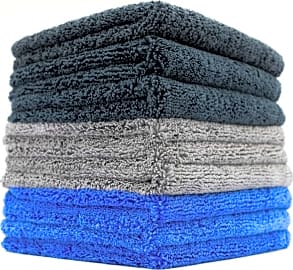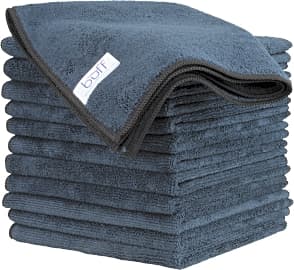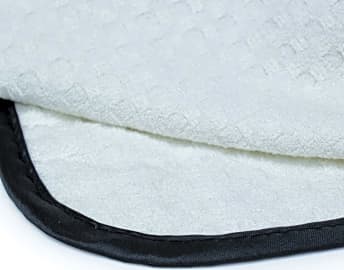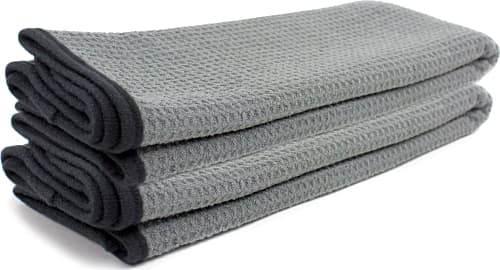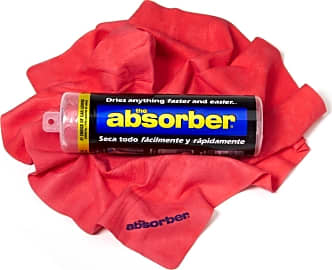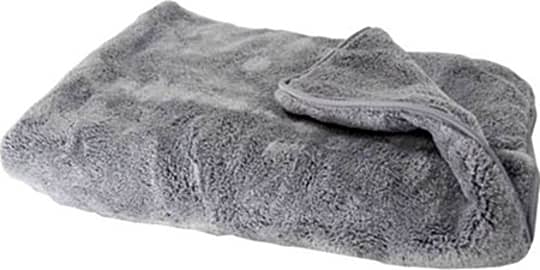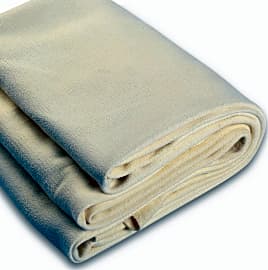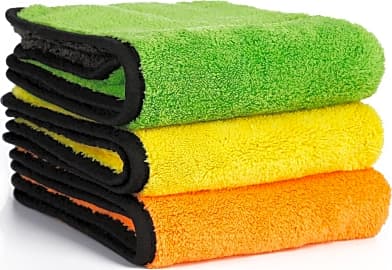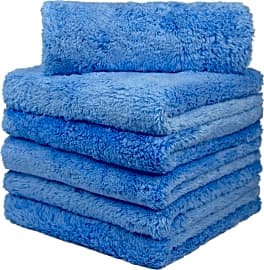The 10 Best Car Drying Towels

This wiki has been updated 29 times since it was first published in March of 2018. Using regular towels to dry your vehicle usually causes streaks and they can shed fuzz all over the bodywork (not to mention the fact that you'll probably get told off for using the guest ones). These dedicated options, however, come in various materials, including chamois and microfiber, that are less likely to leave water spots and unsightly marks or debris on your freshly-cleaned pride and joy. When users buy our independently chosen editorial recommendations, we may earn commissions to help fund the Wiki.
Editor's Notes
June 24, 2019:
If you're into auto detailing, you're probably already familiar with the name, and Meguiar's X2000 Water Magnet still lives up to its first-rate reputation. A waffle-textured option, it absorbs well but won't require wringing out every other minute, so you can finish before air drying causes water spots. And, of course, it's completely machine washable, so there's no annoying hand-washing required. If you're looking for something fluffier, then The Rag Company Spectrum 420 remains the one to beat. These don't have any scratchy tags or rough edges, and they're priced well considering that each order comes with nine towels. We also added the fairly similar Buff Cleaning Cloth, although do note that this version has tags you may wish to remove. They give you great bang for your buck, though, as they can do it all, including cleaning, drying, polishing, and more.
Finally, we have decided to keep the Chemical Guys Woolly Mammoth at this time. This particular towel comes from a well-respected name in car care, but it's a very love-it-or-hate-it option, as some users experience issues with lint. You'll probably want to wash it before you use it. For an alternative that is also highly absorbent, you might consider the CleanTools Absorber, which is a synthetic upgrade over the time-honored natural leather chamois.
Your Towel, Your Choice
You'll also see waffle weave towels, which are generally made from the same materials as microfiber but have a different overall surface construction.
Drying a car sounds oh-so-simple, but the huge number of towels available might leave you feeling fuzzy. You probably know that your typical bath towels are not great for car drying, as they shed lint and can scratch your finish, but you might be wondering how you should replace them. Nowadays, there are two preferred choices: chamois and microfiber. The former is a type of leather, often from a sheep or goat, while the latter is a blend of synthetic fibers (polyester and polyamide). You'll also see waffle weave towels, which are generally made from the same materials as microfiber but have a different overall surface construction. So, what are the pros and cons of each?
A top concern is how well a car drying towel actually dries. While both the chamois and microfiber options are excellent at soaking up water, for many, the microfiber towel has a slight edge thanks to its texture. With its uneven and nubby surface, it can trap small particles away from the car's exterior, preventing small scratches. Chamois cloths have a smoother surface, which means that these small particles have nowhere to hide.
There is also care to consider, as you probably don't want to invest hours into cleaning your washing implements. Again, the microfiber drying towel may have the slight edge, because many are machine washable and quick drying. On the other hand, they may require delicate soap, not laundry detergent, which means more laundry. A chamois cloth can't go in your washing machine and will require delicate soap, as well. You should hang these out to dry and never leave them wadded up wet, as they can rot.
Next up are cost and durability. Today, manufacturing processes have made both chamois and microfiber fairly inexpensive, so either way you go, you aren't looking at an extreme investment. As for durability, both can last for years, as long as you take care of them as the manufacturer suggests.
In the end, then, the choice between microfiber and chamois comes largely down to personal preference. In fact, users often make claims that are diametrically opposite (e.g., microfiber is either easier or harder to care for than chamois, depending upon whom you ask), indicating that there is at least some degree of subjectivity involved.
Streak-Free Drying
Regardless of the type of car drying towel you choose, you'll need sound drying techniques to get a streak-free, glossy shine. We've got a few tips for accomplishing this without any added hassle.
You can use a squeegee to get things going, but if you don't have one, open your towel and drag it across the surfaces to remove the majority of the water.
First, park on a slight incline, if you can, so that the water rolls off instead of standing on surfaces. Once you've rinsed, start drying at the top of the car. You can use a squeegee to get things going, but if you don't have one, open your towel and drag it across the surfaces to remove the majority of the water. You can also blot if you need to, in order to get most of the water off, but don't wipe the towel in big circles.
When most of the water is gone, you're ready to start wiping away the remaining moisture. Some experts suggest applying a light spray wax at this point, so that you're waxing and completing the drying process at the same time. This not only helps you avoid streaks, but saves you some time, too.
Be sure to use different towels for the different processes, such as drying and waxing, so that you always start with a fresh, clean towel for each step. Also, don't use a body towel on the tires. To remember which is which, you might buy different colors and assign each a task (you can do the same with your cleaning buckets, too).
Which Is Your Wash?
As in choosing the perfect car drying towels, brushes, and soaps, the choice between the mechanized and hand wash holds a certain degree of personal preference. There are, however, a few points to consider in making the decision about which to use on a week-to-week basis.
Consider time, for instance. It takes less time to take a trip through a car wash, although if you don't have one near your home or work, you'll lose some time by going out of your way. You could also ask yourself if being in a hurry is always necessary; hand washing your car on the weekend can be a relaxing way to enjoy summer weather and a good excuse to spend time with friends or your kids.
Others claim that there is too much grit inside an automatic wash because so many cars go through them, which can raise the risk.
And then there is cost. You'll need to make a small investment in car washing tools, but in the long run you'll save money. You might even have some items around your house already, like buckets, which offsets some of the initial outlay. Plus, with today's durable materials, your washing mitt and car towels will probably last you quite some time.
As for damage potential, experienced detailing pros disagree about the level of risk in an automatic car wash. To some, there is less risk of damage to your paint job in touchless or soft-cloth car washes because they remove grit that would otherwise be rubbed against the paint during hand washing. Others claim that there is too much grit inside an automatic wash because so many cars go through them, which can raise the risk. Of course, with attention and care, a hand wash can probably be just as grit-free, so the "better" choice may come down to the characteristics of the automatic wash versus the skill of the hand washer.
Last but not least is drying time. Here, the advantage goes to hand drying, as most automatic car washes just cannot beat the human touch. True, their high-powered blowers can remove most of the water, but you'll still find streaking and spots once the car is totally dry. To offset this, you could perhaps stash a car drying towel in your trunk and give your baby a final wipe-down when you come out of the automatic wash.


